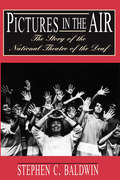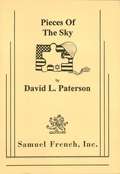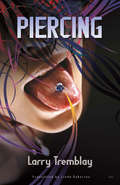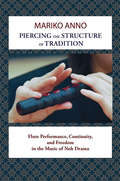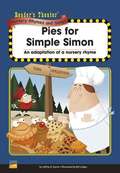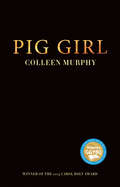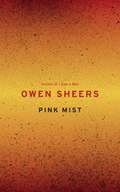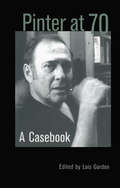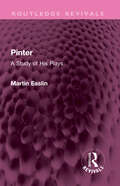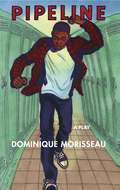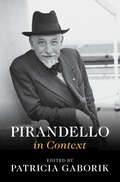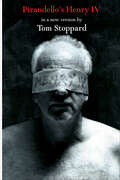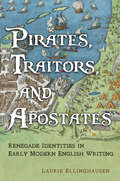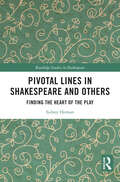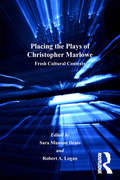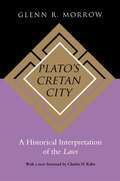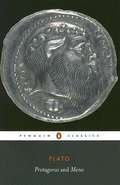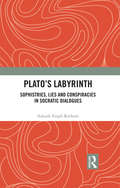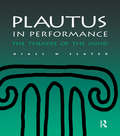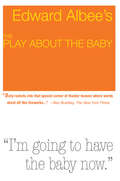- Table View
- List View
Pictures in the Air: The Story of the National Theatre of the Deaf
by Stephen C. BaldwinNow available in paperback; ISBN 1-56368-140-4
Pieces of the Sky
by David PatersonDrama / 4m, 1f / Interior / This drama by the author of The Great Gilly Hopkins and Finger Painting in a Murphy Bed focuses on a strange, intense friendship that develops during World War II in Nebraska. Sarah is an independent and determined middle aged mother who runs a diner in Deliverance and worries about her son, a soldier fighting in Europe. She becomes the Jewish mailman's only friend in town, partly because she feels that a good relationship with the man who brings notices of war deaths will somehow shield her son from harm. Sarah and Joshua put together complex jigsaw puzzles to pass the time, until Sarah thinks he has betrayed her.
Piercing
by Linda Gaboriau Larry TremblayThree tales spin a web of suspense, impending violence and tragedy that haunt the sleek façade of a city.
Piercing the Structure of Tradition: Flute Performance, Continuity, and Freedom in the Music of Noh Drama
by Mariko AnnoWhat does freedom sound like in the context of traditional Japanese theater? Where is the space for innovation, and where can this kind of innovation be located in the rigid instrumentation of the Noh drama? In Piercing the Structure of Tradition, Mariko Anno investigates flute performance as a space to explore the relationship between tradition and innovation. This first English-language monograph traces the characteristics of the Noh flute (nohkan), its music, and transmission methods and considers the instrument's potential for development in the modern world. Anno examines the musical structure and nohkan melodic patterns of five traditional Noh plays and assesses the degree to which Issō School nohkan players maintain to this day the continuity of their musical traditions in three contemporary Noh plays influenced by Yeats. Her ethnographic approach draws on interviews with performers and case studies, as well as her personal reflection as a nohkan performer and disciple under the tutelage of Noh masters. She argues that traditions of musical style and usage remain influential in shaping contemporary Noh composition and performance practice, and the existing freedom within fixed patterns can be understood through a firm foundation in Noh tradition.
Pies for Simple Simon: An Adaptation of a Nursery Rhyme
by Jeffrey B. Fuerst Carrie Smith Bill LedgerNIMAC-sourced textbook
Pig Girl
by Colleen MurphyAt 4:00 a.m. on a secluded farm, a woman fights to take her life back from a serial killer as her desperate sister and a haunted police officer reach across time and distance in an attempt to rescue her.
Pink Mist
by Owen SheersFrom the author of I Saw a Man comes a powerful drama in verse that captures both the trauma of modern warfare and the difficulty of transitioning back to normal life after combat. In early 2008, three young friends from Bristol decide to join the army and are deployed to the conflict in Afghanistan. Within a short space of time the three men return to the women in their lives—a wife, a mother, a girlfriend—all of whom must now share the psychological and physical aftershocks of military service. Written from the points of view of each soldier, Sheers explores not only their experiences in the field of battle, but also the grueling process of recovery following a debilitating injury, the strain of PTSD on a new marriage, and the emotional toll of survivor's guilt among soldiers and their loved ones at home. Drawing on interviews with soldiers and their families, Pink Mist illuminates the enduring human cost of war and its all too often devastating effect upon the young lives pulled into its orbit. A work of great dramatic power, documentary integrity, and emotional intensity.
Pinter at 70: A Casebook (Casebooks on Modern Dramatists #Vol. 30)
by Lois GordonThis comprehensive and authoritative casebook includes cornerstone essays on Pinter's creative process, his politics, film adaptations, and acting career. It also includes a collection of photos found nowhere else that document Pinter's "golden time"--his early acting days in Ireland--, a substantial introduction, a chronology, and bibliography.
Pinter: A Study of His Plays (Routledge Revivals)
by Martin EsslinFirst published in 1977, the third edition of Pinter is an excellent analysis of Harold Pinter and his works. Written when Pinter was only a few plays old, the book draws on several sources, including interviews with Pinter himself, to comment on Pinter’s career, his aesthetic and philosophical choices, and his oeuvre as a writer. The section devoted to his individual plays has been arranged in a chronological manner to visually represent the growth of the playwright and the relationship shared between his early and later works. Esslin, known for coining the term ‘theatre of the absurd,’ was himself an inspiration to Pinter and hence, the book records an intellectual and creative exchange between the author and his subject. The book will be of interest to students of literature, drama, history as well as to an academically inclined theatre audience.
Pipeline
by Dominique Morisseau"Pipeline confirms Dominique Morisseau's reputation as a playwright of piercing eloquence." --Ben Brantley, New York Times With profound compassion and lyricism, Morisseau brings us a powerful play that delves into the urgent issue of the "school-to-prison" pipeline that ensnares people of color. Issues of class, race, parenting, and education in America are brought to the frontlines, as we are left to question the systematic structures that ultimately trap underserved communities.
Pirandello in Context (Literature in Context)
by Patricia GaborikFor students of Luigi Pirandello's life and works, this volume provides a multi-faceted view spanning the many genres in which he wrote, from poetry and essays to fiction and drama. It gives a true sense of Pirandello's remarkable sensitivity to place – from his native Sicily to Germany and Latin America – and of how his perspective was shaped by a wide range of interlocutors with varying professional backgrounds, from contemporary philosophers to fellow playwrights like Bernard Shaw, directors like Max Reinhardt and the actress Marta Abba. Diverse contributors explore the sheer genre-bending originality of Pirandello's humor, metatheatre, and fantastic tales, and reveal how profound shifts in society, culture, and politics in his time – Freud, Futurism, Fascism – conditioned not just his thought but also his meteoric rise to fame. A final section is dedicated to Pirandello's legacy in literature and drama throughout the twentieth century and into the twenty-first.
Pirandello's Henry IV
by Luigi PirandelloThe Italian playwright&’s masterful comedy interrogating the meaning of madness is reimagined in this translation by the author of Leopoldstadt. In this meeting of two of the twentieth century&’s greatest playwrights, Tom Stoppard has reinvigorated Luigi Pirandello&’s masterpiece exploring the nature of madness and the limits of sanity. After a fall from his horse, an Italian aristocrat believes he is the obscure medieval German emperor Henry IV. After twenty years of living this royal illusion, his beloved appears with a noted psychiatrist to shock the madman back to sanity. Their efforts expose that for the past twelve years the nobleman has in fact been sane. With his mask of madness unveiled, the aristocrat launches an offensive to deflect their unwanted attention. While Pirandello&’s characters verbally spar in Stoppardian flourishes, battling for the upper hand—and the greatest laughs—one question emerges: What constitutes sanity?
Pirandello's Theatre of Living Masks
by Umberto Mariani Alice Gladstone MarianiNobel Prize-winning dramatist Luigi Pirandello is known worldwide for his innovative, complex plays. In Pirandello's Theatre of Living Masks, Umberto Mariani and Alice Gladstone Mariani offer the first new edition in nearly sixty years of six of his major works - Liola, It Is So If You Think So, Six Characters in Search of an Author, Henry IV, Each in His Own Way, and The Mountain Giants.Mariani and Mariani's translations of these texts are both vibrant and faithful to the originals, using contemporary expressions and unambiguous language to facilitate readability and comprehension. This edition also offers a critical introduction to each play's most significant characters and structures, highlighting themes and poetics as they correspond to Pirandello's entire body of work. Pirandello's Theatre of Living Masks will appeal to those already familiar with his plays and those looking to discover one of the twentieth century's great dramatists.
Pirates, Traitors, and Apostates: Renegade Identities in Early Modern English Writing
by Laurie EllinghausenExamining tales of notorious figures in Renaissance England, including the mercenary Thomas Stukeley, the Barbary corsair John Ward, and the wandering adventurers the Sherley brothers, Laurie Ellinghausen sheds new light on the construction of the early modern renegade and its depiction in English prose, poetry, and drama during a period of capitalist expansion. Unlike previous scholarship which has focused heavily on positioning rogue behaviour within the dialogue of race, gender, religion, and nationalism, Pirates, Traitors, and Apostates: Renegade Identities in Early Modern England shows how domestic issues of class and occupation exerted a major influence on representations of renegades, and heightened their appeal to the diverse audiences of early modern England. By looking at renegade tales from this perspective, Ellinghausen reveals a renegade, who, despite being stigmatized as an outsider, becomes a major profiteer during the period of early expansion, and ultimately a key figure in the creation of a national English identity.
Pivotal Lines in Shakespeare and Others: Finding the Heart of the Play (Routledge Studies in Shakespeare)
by Sidney HomanPivotal Lines in Shakespeare and Others defines a pivotal line as "a moment in the script that serves as a pathway into the larger play … a magnet to which the rest of the play, scenes before and after, adheres." Homan offers his personal choices of such lines in five plays by Shakespeare and works by Beckett, Brecht, Pinter, Shepard, and Stoppard. Drawing on his own experience in the theatre as actor and director and on campus as a teacher and scholar, he pairs a Shakespearean play with one by a modern playwright as mirrors for each other. One reviewer calls his approach "ground-breaking." Another observes that his "experience with the particular plays he has chosen is invaluable" since it allows us to find "a wedge into such iconic texts." Academics and students alike will find this volume particularly useful in aiding their own discovery of a pivotal line or moment in the experience of reading about, watching, or performing in a play.
Placing the Plays of Christopher Marlowe: Fresh Cultural Contexts
by Sara Munson DeatsFocusing upon Marlowe the playwright as opposed to Marlowe the man, the essays in this collection position the dramatist's plays within the dramaturgical, ethical, and sociopolitical matrices of his own era. The volume also examines some of the most heated controversies of the early modern period, such as the anti-theatrical debate, the relations between parents and children, Machiavaelli¹s ideology, the legitimacy of sectarian violence, and the discourse of addiction. Some of the chapters also explore Marlowe's polysemous influence on the theater of his time and of later periods, but, most centrally, upon his more famous contemporary poet/playwright, William Shakespeare.
Plato's Cretan City: A Historical Interpretation of the Laws
by Glenn R. MorrowPlato's Cretan City is a thorough investigation into the roots of Plato's Laws and a compelling explication of his ideas on legislation and social institutions. A dialogue among three travelers, the Laws proposes a detailed plan for administering a new colony on the island of Crete. In examining this dialogue, Glenn Morrow describes the contemporary Greek institutions in Athens, Crete, and Sparta on which Plato based his model city, and explores the philosopher's proposed regulations concerning property, the family, government, and the administration of justice, education, and religion. He approaches the Laws as both a living document of reform and a philosophical inquiry into humankind's highest earthly duty.
Plato: Protagoras and Meno
by Plato Adam Beresford Lesley BrownPlato's finest dramatic work, an entertaining tale of goodness and knowledge Exploring the question of what exactly makes good people good, Protagoras and Meno are two of the most enjoyable and accessible of all of Plato's dialogues. Widely regarded as his finest dramatic work, the Protagoras, set during the golden age of Pericles, pits a youthful Socrates against the revered sophist Protagoras, whose brilliance and humanity make him one the most interesting and likeable of Socrates' philosophical opponents, and turns their encounter into a genuine and lively battle of minds. The Meno sees an older but ever ironic Socrates humbling a proud young aristocrat as they search for a clear understanding of what it is to be a good man, and setting out the startling idea that all human learning may be the recovery of knowledge already possessed by our immortal souls.
Plato’s Labyrinth: Sophistries, Lies and Conspiracies in Socratic Dialogues
by Aakash Singh RathoreThis original and stimulating study of Plato's Socratic dialogues rereads and reinterprets Plato's writings in terms of their dialogical or dramatic form. Taking inspiration from the techniques of Umberto Eco, Jacques Derrida, and Leo Strauss, Aakash Singh Rathore presents the Socratic dialogues as labyrinthine texts replete with sophistries and lies that mask behind them important philosophical and political conspiracies. Plato's Labyrinth argues that these conspiracies and intrigues are of manifold kinds – in some, Plato is masterminding the conspiracy; in others, Socrates, or the Sophists, are the victims of the conspiracies. With supplementary forays ('intermissions') into the world of Xenophon and the Sophists, the complex and evolving series of overlapping arguments that the book lays out unfold within an edgy and dramatic narrative. Presenting innovative readings of major texts – Plato's Parmenides, Republic, Symposium and Meno as also Homer's Odyssey – this work is an ambitious attempt to synthesize philological, political, historical and philosophical research into a classical text-centred study that is at once of urgent contemporary relevance. This book aims to revitalize the study of ancient Greek thought in all its diverse disciplinary richness and will interest students and scholars across the social sciences and humanities, especially those in philosophy, Greek and classical studies, language and literature, politics, media and culture studies, theatre and performance studies, and history.
Plautus in Performance: The Theatre of the Mind (Greek And Roman Theatre Archive Ser. #Vol. 2.)
by Niall W. SlaterPlautus was Ancient Rome's greatest comic playwright, Shakespeare drew heavily on his plots, and his legacy is prevalent throughout modern drama. In this expanded edition of his successful book, one of America's foremost Classical scholars introduces performance criticism to the study of Plautus' ancient drama. In addition to the original detailed studies of six of the dramatists's plays, the methodology of performance criticism, the use of conventions, and the nature of comic heroism in Plautus, this edition includes new studies on: * the induction into the world of the play * the scripted imitation of improvisation * Plautus's comments on his previous work * the nature of 'tragicomedy'.
Play About the Baby: Trade Edition
by Edward AlbeeWinner of three Pulitzer Prizes for Drama during his long and distinguished career, Edward Albee is one of America’s preeminent playwrights. The Play About the Baby is an absurdist black comedy, reminiscent of burlesque in its high spirits and banter, that grapples with such issues as reality and the games we play to define it, the ambiguity of existence, and the agonizing bonds between parents and children. A fresh young couple—Boy and Girl—have a new baby, whom an older couple—Man and Woman—have come to steal. Why? Because, as Man says, “If you don’t have the wound of a broken heart, how can you know you’re alive?” Brutal loss—the loss of a child or childhood self—has been a recurring Albee theme, and Ben Brantley of the New York Times summed up the critical reaction to The Play About the Baby when he called it a “funny, harrowing dramatic fable … as explicit and concise a statement of what Mr. Albee believes as he is ever likely to deliver.”
Play About the Baby: Trade Edition
by Edward AlbeeWinner of three Pulitzer Prizes for Drama during his long and distinguished career, Edward Albee is one of America's preeminent playwrights. The Play About the Baby is an absurdist black comedy, reminiscent of burlesque in its high spirits and banter, that grapples with such issues as reality and the games we play to define it, the ambiguity of existence, and the agonizing bonds between parents and children. A fresh young couple--Boy and Girl--have a new baby, whom an older couple--Man and Woman--have come to steal. Why? Because, as Man says, "If you don't have the wound of a broken heart, how can you know you're alive?" Brutal loss--the loss of a child or childhood self--has been a recurring Albee theme, and Ben Brantley of the New York Times summed up the critical reaction to The Play About the Baby when he called it a "funny, harrowing dramatic fable ... as explicit and concise a statement of what Mr. Albee believes as he is ever likely to deliver."
Play Directing: Analysis, Communication, and Style
by Michael Mclain Francis HodgePlay Directing describes the various roles a director plays, from selection and analysis of the play, to working with actors and designers to bring the production to life.
Play Directing: The Basics (The Basics)
by Damon KielyPlay Directing: The Basics introduces theatre students to a step-by-step process for directing plays, including advice on devising. Beginning with a historical overview of directing, this book covers every aspect of the director’s job from first read to closing night. Practical advice on finding plays to produce, analysing scripts, collaborating with the design team, rehearsing with actors, devising company creations, and opening a show are peppered with advice from working professionals and academic directors. A practical workbook, short exercises, helpful websites, and suggested reading encourage readers towards a deeper study of the art of directing. This book empowers high school and early college students interested in theatre and directing to find their own voice, develop a practice, and refine their process.
